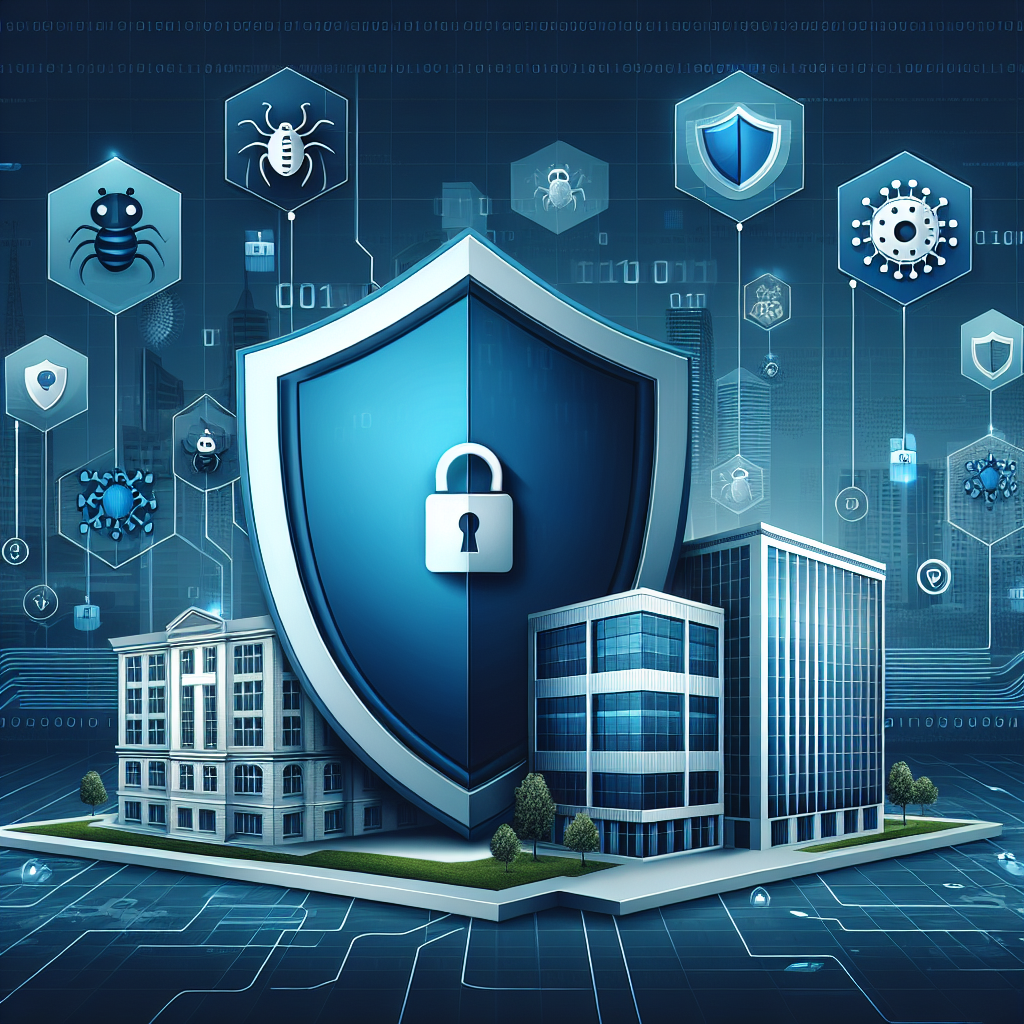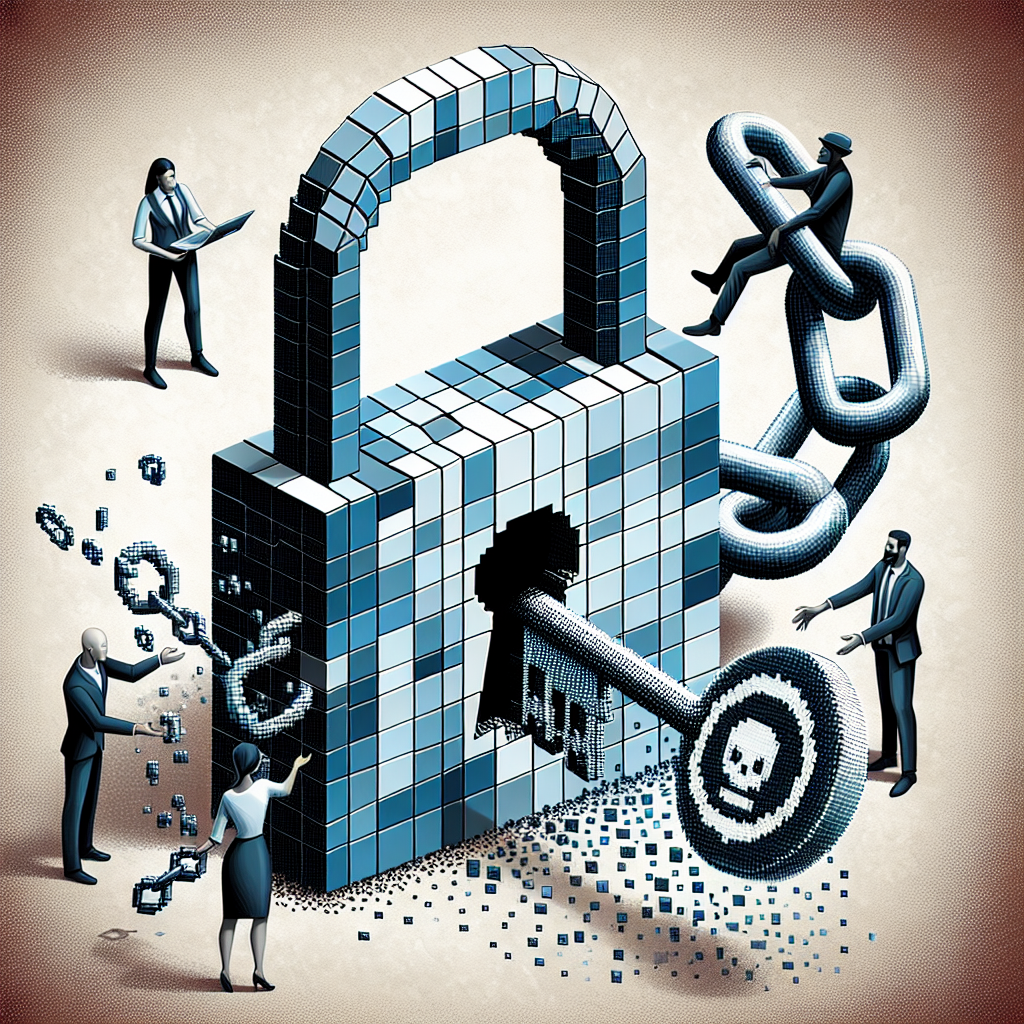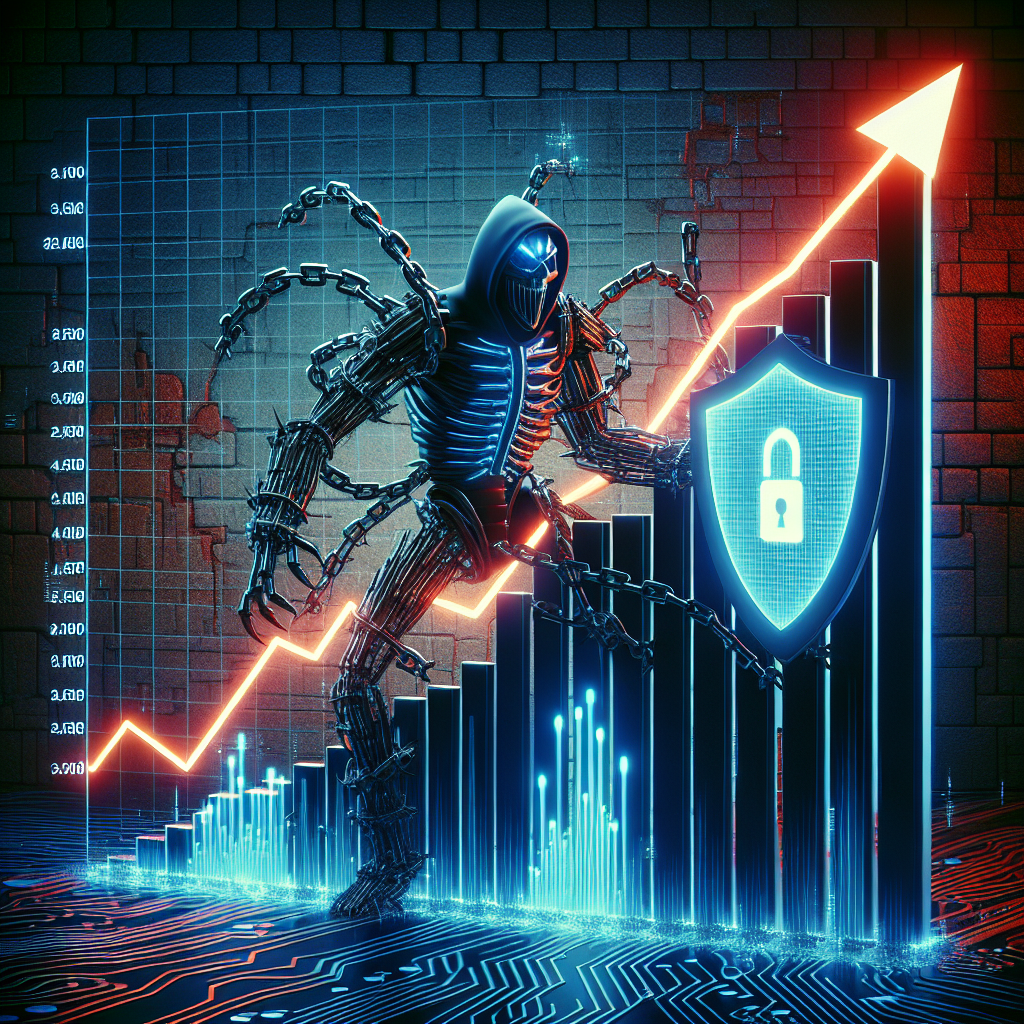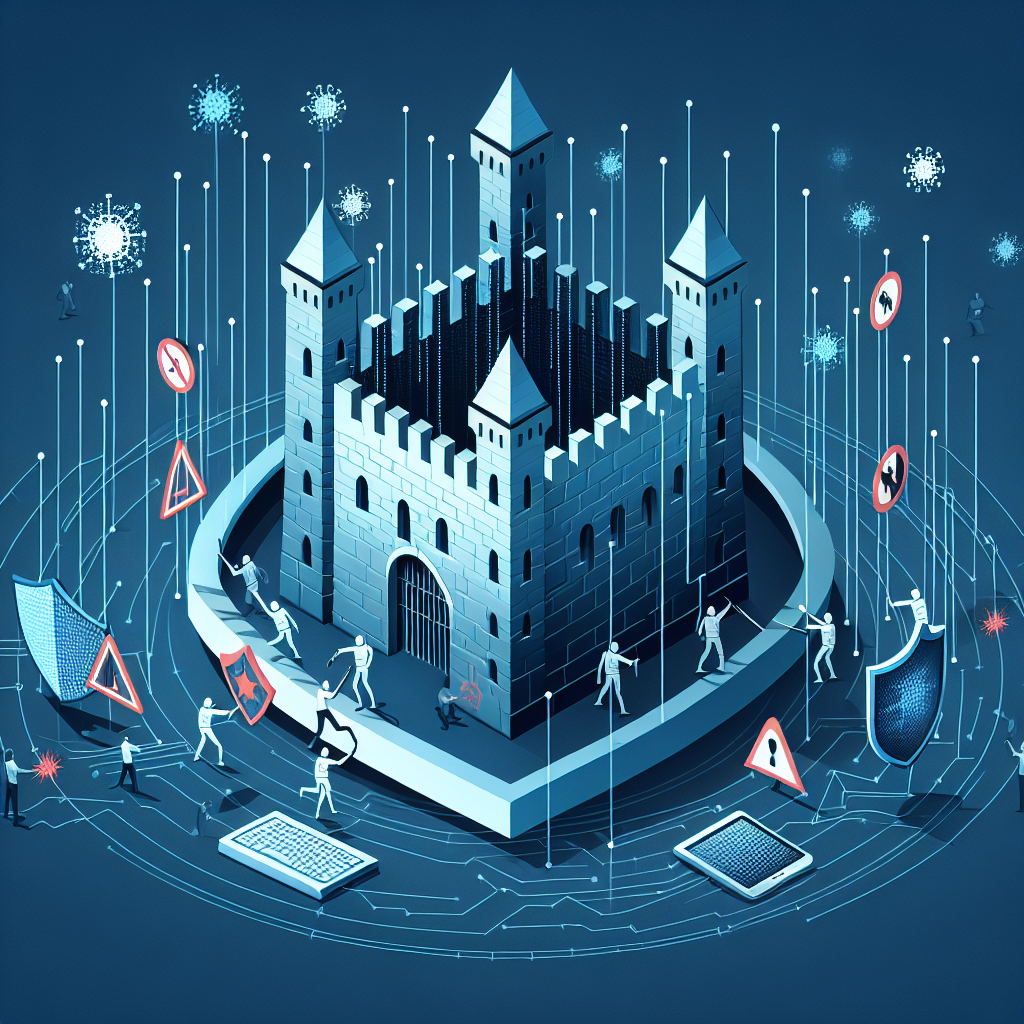Your cart is currently empty!
Tag: Attacks

How to Protect Your Business from Cyber Attacks: A Comprehensive Guide to Cybersecurity
In today’s digital age, businesses face an increasing threat of cyber attacks that can compromise sensitive information, disrupt operations, and damage their reputation. It is crucial for business owners to prioritize cybersecurity measures to protect their organizations from these threats. This comprehensive guide will outline key steps that businesses can take to safeguard their systems and data from cyber attacks.1. Conduct a Cybersecurity Assessment: The first step in protecting your business from cyber attacks is to assess your current cybersecurity posture. This includes identifying potential vulnerabilities in your systems, network, and processes. Conducting a thorough assessment will help you understand the specific risks facing your business and develop a targeted cybersecurity strategy.
2. Implement Strong Password Policies: Weak passwords are a common entry point for cyber attackers. Ensure that all employees use strong, unique passwords for their accounts and regularly update them. Consider implementing multi-factor authentication for an added layer of security.
3. Keep Software and Systems Updated: Cyber attackers often exploit known vulnerabilities in software and systems to gain unauthorized access. To mitigate this risk, regularly update all software, applications, and operating systems with the latest security patches and updates.
4. Educate Employees on Cybersecurity Best Practices: Human error is a significant factor in many cyber attacks. Provide comprehensive cybersecurity training to employees to raise awareness of common threats, such as phishing scams and social engineering attacks. Encourage employees to be vigilant and report any suspicious activity immediately.
5. Secure Your Network: Implement robust network security measures, such as firewalls, intrusion detection systems, and encryption, to protect your business’ data and communications. Restrict access to sensitive information on a need-to-know basis and regularly monitor network activity for any signs of unauthorized access.
6. Backup Your Data Regularly: In the event of a cyber attack or data breach, having regular backups of your business’ data is essential for recovery. Store backups securely offsite or in the cloud to prevent them from being compromised in the event of a cyber attack.
7. Develop an Incident Response Plan: Despite your best efforts, cyber attacks can still occur. Develop a comprehensive incident response plan that outlines the steps to take in the event of a security breach. Assign roles and responsibilities to key personnel, establish communication protocols, and test the plan regularly to ensure its effectiveness.
8. Partner with a Managed Security Services Provider: For businesses that lack the resources or expertise to manage cybersecurity internally, partnering with a managed security services provider can provide an added layer of protection. These professionals can help identify and mitigate security risks, monitor for threats, and respond to incidents in a timely manner.
By following these cybersecurity best practices, businesses can enhance their defenses against cyber attacks and safeguard their valuable data and assets. Investing in cybersecurity is not only necessary to protect your business but also to build trust with customers and partners. Stay proactive and stay safe in the digital landscape.

The Growing Threat of Ransomware Attacks and How to Prevent Them
Ransomware attacks have become an increasingly prevalent threat in today’s digital world. These attacks involve cybercriminals gaining access to a victim’s computer or network and encrypting their files, rendering them inaccessible. The attackers then demand a ransom in exchange for the decryption key, often in the form of cryptocurrency.The impact of ransomware attacks can be devastating, causing financial loss, data breaches, and disruption to business operations. In recent years, high-profile attacks on companies, healthcare organizations, and government agencies have highlighted the growing threat posed by ransomware.
So, how can individuals and organizations protect themselves from falling victim to these attacks? Here are some key steps to prevent ransomware attacks:
1. Keep your software up to date: Regularly update your operating system, antivirus software, and other applications to patch any vulnerabilities that could be exploited by cybercriminals.
2. Use strong passwords: Create complex passwords that are difficult to guess and change them regularly. Consider using a password manager to securely store and manage your passwords.
3. Be cautious of suspicious emails: Avoid clicking on links or downloading attachments from unknown or suspicious emails. Phishing emails are a common method used by cybercriminals to distribute ransomware.
4. Backup your data: Regularly back up your important files and data to an external hard drive or cloud storage service. In the event of a ransomware attack, you can restore your files from backup without having to pay the ransom.
5. Implement security measures: Use firewalls, antivirus software, and intrusion detection systems to prevent unauthorized access to your computer or network. Consider using endpoint security solutions that can detect and block ransomware attacks.
6. Educate employees: Train your employees on how to recognize and avoid ransomware attacks. Teach them about the importance of cybersecurity best practices and how to report suspicious activity.
7. Develop a response plan: In the event of a ransomware attack, have a response plan in place to quickly contain the infection, restore data from backups, and report the incident to law enforcement.
By taking proactive steps to prevent ransomware attacks, individuals and organizations can significantly reduce their risk of falling victim to these increasingly sophisticated cyber threats. Remember that prevention is key when it comes to cybersecurity, so stay vigilant and stay protected.

The Rise of Ransomware Attacks and How to Prevent Them
Ransomware attacks have been on the rise in recent years, causing significant damage to individuals and organizations alike. These attacks involve cybercriminals encrypting a victim’s files and demanding a ransom in exchange for the decryption key. The consequences of falling victim to a ransomware attack can be devastating, resulting in data loss, financial loss, and damage to a company’s reputation.There are several factors contributing to the rise of ransomware attacks. One major factor is the increasing sophistication of cybercriminals, who are constantly developing new ways to infiltrate systems and evade detection. Additionally, the rise of remote work and the use of cloud services have provided more opportunities for ransomware attacks, as employees may be more vulnerable when working outside of the company’s secure network.
To prevent falling victim to a ransomware attack, there are several steps individuals and organizations can take to protect themselves. First and foremost, it is crucial to regularly back up all important data and ensure that backups are stored securely and offline. This way, even if a ransomware attack occurs, the victim can restore their data without having to pay a ransom.
It is also important to keep all software and systems up to date with the latest security patches and updates. Cybercriminals often exploit vulnerabilities in outdated software to gain access to a victim’s system. Additionally, individuals and organizations should invest in comprehensive cybersecurity solutions, such as anti-virus software, firewalls, and intrusion detection systems, to detect and prevent ransomware attacks.
Furthermore, it is essential to educate employees on cybersecurity best practices, such as avoiding suspicious links and email attachments, and using strong, unique passwords. Regular training and awareness programs can help employees recognize and respond to potential ransomware threats.
In the event of a ransomware attack, it is important to remain calm and not pay the ransom. There is no guarantee that the cybercriminals will provide the decryption key, and paying the ransom only encourages further attacks. Instead, victims should report the attack to their IT department or a cybersecurity professional, who may be able to help decrypt the files or recover data from backups.
Overall, the rise of ransomware attacks highlights the importance of proactive cybersecurity measures. By implementing best practices and staying vigilant, individuals and organizations can reduce their risk of falling victim to a ransomware attack and protect their valuable data and assets.

Best Practices for Protecting Your Business from Cyber Attacks
In today’s digital age, cyber attacks are a growing threat to businesses of all sizes. From data breaches to ransomware attacks, the consequences of a cyber attack can be devastating to a business’s bottom line and reputation. That’s why it’s crucial for businesses to implement best practices for protecting themselves from cyber attacks.One of the most important steps that businesses can take to protect themselves from cyber attacks is to educate their employees about cybersecurity best practices. This includes training employees on how to recognize phishing emails, use strong passwords, and secure their devices. By educating employees about the risks of cyber attacks and how to prevent them, businesses can significantly reduce their vulnerability to these threats.
Another important best practice for protecting your business from cyber attacks is to regularly update your software and systems. Cyber attackers are constantly evolving their tactics, so it’s crucial for businesses to stay one step ahead by keeping their software and systems up to date with the latest security patches and updates. This can help prevent hackers from exploiting known vulnerabilities in outdated software.
In addition to updating software and systems, businesses should also implement strong access controls to protect their sensitive data. This includes limiting access to sensitive information to only those employees who need it, as well as using encryption to protect data both in transit and at rest. By implementing strong access controls, businesses can reduce the risk of unauthorized access to their data.
Regularly backing up data is another important best practice for protecting your business from cyber attacks. In the event of a ransomware attack or data breach, having regularly updated backups of your data can help you quickly recover and minimize the impact of the attack. Businesses should also test their backups regularly to ensure that they are working properly and can be easily restored in the event of an attack.
Finally, businesses should consider investing in cybersecurity insurance to help mitigate the financial impact of a cyber attack. Cybersecurity insurance can help cover the costs of investigating and remediating a cyber attack, as well as any legal fees or fines that may result from a data breach. By having cybersecurity insurance, businesses can have peace of mind knowing that they are financially protected in the event of a cyber attack.
In conclusion, cyber attacks are a growing threat to businesses, but by implementing best practices for cybersecurity, businesses can significantly reduce their risk of falling victim to these attacks. By educating employees, regularly updating software and systems, implementing strong access controls, backing up data, and investing in cybersecurity insurance, businesses can protect themselves from the financial and reputational damage that can result from a cyber attack.

Protecting Your Business from Cyber Attacks: Strategies for Success
In today’s digital age, protecting your business from cyber attacks is more important than ever. With the increasing reliance on technology and the internet for daily operations, businesses are at a higher risk of falling victim to cyber threats. From data breaches to ransomware attacks, cyber criminals are constantly looking for ways to exploit vulnerabilities in your systems.To ensure the safety and security of your business, it is crucial to implement effective strategies to protect against cyber attacks. Here are some key strategies for success:
1. Regularly update your software and systems: One of the easiest ways for cyber criminals to gain access to your business is through outdated software and systems. Make sure to regularly update all of your software, including operating systems, antivirus programs, and firewalls, to ensure that you have the latest security patches and protections in place.
2. Train your employees on cybersecurity best practices: Your employees are often the first line of defense against cyber attacks. Make sure to provide regular training on cybersecurity best practices, such as how to recognize phishing emails, how to create strong passwords, and how to secure sensitive information. Additionally, establish clear protocols for reporting any suspicious activity or security incidents.
3. Implement strong access controls: Limiting access to sensitive data and systems is essential for protecting your business from cyber attacks. Implement strong access controls, such as multi-factor authentication and role-based access, to ensure that only authorized individuals can access sensitive information.
4. Backup your data regularly: In the event of a cyber attack, having a backup of your data is crucial for recovering quickly and minimizing damage. Make sure to regularly backup your data to a secure, offsite location, and test your backups regularly to ensure that they are up-to-date and accessible.
5. Monitor your systems for suspicious activity: Implementing a robust monitoring system can help you detect and respond to cyber threats in real-time. Monitor your systems for any unusual activity, such as unauthorized access attempts or unusual network traffic, and respond promptly to any potential security incidents.
6. Develop a comprehensive incident response plan: Despite your best efforts, it’s still possible that your business may fall victim to a cyber attack. Developing a comprehensive incident response plan can help you respond quickly and effectively to any security incidents, minimizing the impact on your business.
By implementing these strategies for success, you can protect your business from cyber attacks and ensure the safety and security of your sensitive information. Remember, cybersecurity is an ongoing process, so make sure to regularly review and update your security measures to stay ahead of evolving cyber threats.

The Cost of Cyber Attacks: Why Investing in Cybersecurity is Crucial
The Cost of Cyber Attacks: Why Investing in Cybersecurity is CrucialIn today’s digital age, cyber attacks have become a major threat to businesses of all sizes. From small startups to large corporations, no one is safe from the potential damage that can be caused by a cyber attack. These attacks can result in financial losses, damage to reputation, and even legal consequences. That’s why investing in cybersecurity is crucial for any organization looking to protect itself from these threats.
One of the biggest costs associated with cyber attacks is financial loss. According to a report by IBM Security, the average cost of a data breach in 2020 was $3.86 million. This includes expenses such as investigating the breach, notifying affected customers, and implementing security measures to prevent future attacks. For small businesses, the cost of a cyber attack can be even more devastating, with some estimates suggesting that 60% of small businesses that suffer a cyber attack go out of business within six months.
Aside from financial losses, cyber attacks can also have a significant impact on a company’s reputation. A data breach can erode customer trust and loyalty, leading to a loss of business and damage to the brand’s reputation. In today’s interconnected world, news of a cyber attack spreads quickly, and customers are quick to abandon companies that fail to protect their personal information.
Furthermore, failing to invest in cybersecurity can also lead to legal consequences. Many industries have strict regulations in place regarding the protection of sensitive data, such as the Health Insurance Portability and Accountability Act (HIPAA) for healthcare organizations and the General Data Protection Regulation (GDPR) for companies operating in the European Union. Failing to comply with these regulations can result in hefty fines and legal action.
Given the high costs associated with cyber attacks, investing in cybersecurity is essential for any organization looking to protect itself from these threats. This includes implementing robust security measures such as firewalls, antivirus software, and encryption, as well as conducting regular security audits and employee training to ensure that everyone in the organization is aware of best practices for avoiding cyber attacks.
Ultimately, the cost of investing in cybersecurity is far outweighed by the potential costs of a cyber attack. By taking proactive measures to protect their data and systems, businesses can safeguard themselves against the financial, reputational, and legal consequences of a cyber attack. In today’s digital world, cybersecurity is not just an option – it’s a necessity.
Russian attacks against Ukraine kill 9, injure 36 over past day
Russian attacks across Ukraine killed at least 9 civilians and injured at least 36 over the past day, regional authorities reported on Feb. 1.
In Poltava, at least four people were killed and 13 wounded due to a Russian missile strike on a residential building on the morning of Feb. 1, the State Emergency service reported. The toll could rise as a search and rescue operation is ongoing.
One man was killed and four people wounded in Kherson Oblast, Governor Oleksandr Prokudin reported. A 22-year-old man was killed after an explosive was dropped from a Russian drone, he added.
Three policemen were killed on duty overnight in Sumy Oblast in a Russian aviation strike on the Yunakivska community, Sumy Oblast Military administration reported.
A 60-year-old woman was killed and four people wounded in Kharkiv after the intercepted Russian drone fell on a residential area, said Governor Oleh Syniehubov. Two more people were wounded in a shelling in Kupiansk district of Kharkiv Oblast. In total, Russia launched 17 drones and six missiles at civilians and infrastructure, he added.
In Odesa, seven people were wounded after Russian forces a launched missile strike on the city’s historic center on the evening of Jan. 31.
Russian attacks in Donetsk Oblast injured three people, including two in Pokrovsk and one in Katerynivka, according to the Governor Vadym Filashkin.
Two people were wounded in attacks on Dnipropetrovsk Oblast, including a 47-year-old man and 79-year-old woman, said Governor Serhii Lysak.
One 57-year-old man was wounded in an overnight attack in Zaporizhzhia, according to the Governor Ivan Fedorov. Russia launched a total of 16 drones on the city, the Internal Affairs Ministry reported. The attack damaged 14 high-rise residential buildings and around 10 houses, he said in an interview.
Residential areas were hit in Kyiv and Khmelnytska oblasts, according to regional administrations. In Khmelnytska Oblast, eight drones were intercepted by air defense, said Governor Serhii Turin.
“Last night, Russia attacked our cities using various types of weapons: missiles, attack drones, and aerial bombs. Another terrorist crime,” President Volodymyr Zelensky wrote on Telegram in response to the attacks.
“Each such terrorist attack proves that we need more support in defending ourselves against Russian terror. Every air defense system, every anti-missile is a life-saver,” he added.
At least 3 dead, 10 injured in Poltava after Russian missile strike on residential building
A Russian missile struck a residential building in Poltava on Feb. 1, killing at least three people and injuring 10 others, the Ukrainian State Emergency service reported.

In the latest wave of violence, Russian attacks against Ukraine have left 9 dead and 36 injured over the past day. The ongoing conflict in eastern Ukraine shows no signs of easing, as both sides continue to engage in deadly clashes. The international community has condemned the Russian aggression and called for an immediate ceasefire to prevent further loss of life. Our thoughts are with the victims and their families during this difficult time. #Ukraine #Russia #Conflict #Ceasefire
Tags:
- Russian attacks
- Ukraine conflict
- Casualties in Ukraine
- War in Eastern Europe
- International conflicts
- Military aggression
- Eastern Ukraine violence
- Russia-Ukraine tensions
- Ukraine news
- Conflict updates
#Russian #attacks #Ukraine #kill #injure #day
State-sponsored Actors Abusing Gemini to Fuel Cyber Attacks
The state-sponsored threat actors are increasingly exploiting Google’s AI-powered assistant, Gemini, to enhance their cyber operations.
While generative AI tools like Gemini hold immense potential for innovation and productivity, their misuse by advanced persistent threat (APT) groups and information operations (IO) actors underscores the dual-use nature of such technologies.
Google’s Threat Intelligence Group (GTIG) has conducted an in-depth analysis of Gemini’s misuse by government-backed cyber actors.
The findings reveal that while these actors have not yet developed novel AI-enabled attack techniques, they are leveraging Gemini to streamline and accelerate various phases of the cyberattack lifecycle.
APT Groups’ Activities
Iranian APT Actors: Iranian groups were the most prolific users of Gemini, employing it for tasks such as reconnaissance on defense organizations, researching vulnerabilities, crafting phishing campaigns, and creating content with cybersecurity themes.
Notably, APT42 focused on generating tailored phishing materials targeting U.S. defense organizations.
Chinese APT Actors: Chinese groups used Gemini for reconnaissance, scripting tasks, and post-compromise activities like privilege escalation and data exfiltration.
North Korean APT Actors: North Korean groups utilized Gemini for payload development, reconnaissance on South Korean military targets, and even drafting cover letters to support clandestine IT worker schemes aimed at infiltrating Western companies.
Russian APT Actors: Russian actors showed limited engagement with Gemini but used it for tasks like rewriting malware into different programming languages and adding encryption functionality to malicious code.
IO actors from Iran, China, and Russia employed Gemini for content generation, translation, and localization to craft persuasive narratives for influence campaigns. For example:
- Iranian IO actors used Gemini to generate SEO-optimized content and tailor messaging for specific audiences.
- Pro-China IO group DRAGONBRIDGE leveraged the tool for research into foreign political figures and current events.
- Russian IO actors explored using AI tools for textual content analysis and social media campaign planning.
Despite Gemini’s robust safety measures, threat actors attempted various techniques to bypass its safeguards, reads Google’s Threat Intelligence Group report.
Jailbreak Prompts: Some actors used publicly available jailbreak prompts to request malicious code generation. These attempts were largely unsuccessful as Gemini’s safety protocols filtered out harmful outputs.
Reconnaissance on Google Products: Actors sought guidance on abusing Google services like Gmail phishing or bypassing account verification methods. However, these efforts were thwarted by Gemini’s security filters.
The misuse of generative AI tools like Gemini raises significant concerns:
Scalability of Attacks: Generative AI enables threat actors to automate tasks such as vulnerability research and phishing email creation, allowing them to operate at greater scale and speed.
Reduce the learning curve: Less skilled actors can leverage AI tools to quickly acquire capabilities previously limited to more experienced hackers.
Ethical Concerns: The availability of jailbroken or maliciously trained AI models on dark web forums (e.g., WormGPT) raises the risk of widespread abuse.
While generative AI tools like Gemini are not yet enabling breakthrough capabilities for cyberattacks, their misuse by state-sponsored actors highlights the evolving threat landscape.
State-sponsored actors are increasingly abusing the Gemini cryptocurrency exchange platform to fuel cyber attacks around the world. Gemini, known for its strong security measures and compliance with regulatory standards, has become a target for these malicious actors seeking to evade detection and launder their ill-gotten gains.These state-sponsored actors are using Gemini to exchange stolen funds, purchase malicious tools and services, and fund their operations with impunity. By leveraging the anonymity and security features of Gemini, these cyber criminals are able to operate under the radar and avoid detection by law enforcement agencies.
The rise of state-sponsored actors abusing Gemini is a troubling trend that poses a significant threat to the integrity of the cryptocurrency industry. As more and more cyber attacks are attributed to these malicious actors, it is imperative that Gemini and other cryptocurrency exchanges strengthen their security measures and collaborate with law enforcement agencies to combat this growing threat.
In conclusion, the abuse of Gemini by state-sponsored actors to fuel cyber attacks is a pressing issue that requires immediate attention and action. It is essential for the cryptocurrency industry to work together to identify and root out these malicious actors before they cause further harm to innocent victims.
Tags:
- State-sponsored cyber attacks
- Gemini cryptocurrency exchange
- Cybersecurity threats
- Government-sponsored hacking
- Cyber warfare tactics
- Cybersecurity vulnerabilities
- Cybercrime tactics
- Cyber attack prevention
- Cybersecurity measures
- State-sponsored hacking techniques
#Statesponsored #Actors #Abusing #Gemini #Fuel #Cyber #Attacks
I Survived the Shark Attacks of 1916 (I Survived Graphic Novels) – VERY GOOD

I Survived the Shark Attacks of 1916 (I Survived Graphic Novels) – VERY GOOD
Price : 4.33
Ends on : N/A
View on eBay
I Survived the Shark Attacks of 1916 (I Survived Graphic Novels) – VERY GOODIf you’re a fan of thrilling and heart-pounding stories, then you definitely need to check out the latest addition to the “I Survived” series – “I Survived the Shark Attacks of 1916” in graphic novel format! This gripping tale follows the harrowing experience of a young boy named Chet as he faces the terror of shark attacks along the New Jersey coast.
Filled with stunning illustrations that bring the story to life, this graphic novel is sure to keep you on the edge of your seat from start to finish. The intense action and suspense will have you rooting for Chet as he fights for survival against one of nature’s deadliest predators.
Not only does this graphic novel provide a thrilling read, but it also offers a glimpse into the true events that inspired the story. Learn about the shocking shark attacks that took place in 1916 and the impact they had on the local community.
Whether you’re a fan of history, adventure, or just a good old-fashioned survival story, “I Survived the Shark Attacks of 1916” is a must-read. Pick up your copy today and prepare to be captivated by this unforgettable tale of courage and resilience.
#Survived #Shark #Attacks #Survived #Graphic #Novels #GOOD,ages 3+Steph De Lander returns on TNA iMPACT with Digital Media Title, introduces Mance Warner & he attacks Sami Callihan

De Lander returns and introduces her real-life boyfriend, Mance Warner.
Vignettes have been airing on TNA iMPACT with the number ’23’ being the focus point. On the live edition of the program on 1/23, Sami Callihan took to the ring to find out for himself who the vignettes are for.
Out came Steph De Lander, who underwent successful neck surgery in October. She had the TNA Digital Media Championship on her shoulder. De Lander stated that she won the title in the divorce. She was referring to her on-screen marriage to PCO, who is no longer with the promotion.
De Lander then went on to introduce the new Digital Media Champion, former GCW World Champion Mance Warner. Warner attacked Callihan from behind and then hit Callihan with the belt. De Lander and Warner kissed as he held the championship in his hands.
At GCW’s The People vs. GCW, PCO destroyed the Digital Media Title belt with a sledgehammer and then delivered a promo about his time with TNA. GCW owner Brett Lauderdale stated that he did not expect PCO to do what he did at the event.
Steph De Lander makes a triumphant return to TNA iMPACT with a Digital Media Title in hand, ready to take on all challengers. But that’s not all – she also introduces a new face to the roster, the wild and unpredictable Mance Warner.As De Lander addresses the crowd and talks about her plans for the Digital Media Title, Sami Callihan interrupts, looking for a fight. But before things can escalate, Warner makes his presence known, attacking Callihan and sending a clear message that he’s here to shake things up.
With De Lander leading the charge and Warner bringing his unique brand of chaos to the mix, TNA iMPACT is set to become a battleground like never before. Stay tuned for more action, drama, and surprises as this new chapter unfolds in the world of professional wrestling.
Tags:
Steph De Lander, TNA iMPACT, Digital Media Title, Mance Warner, Sami Callihan, wrestling, professional wrestling, return, debut, attack, storyline, TNA Wrestling, Impact Wrestling, entertainment, sports entertainment, wrestling news, wrestling updates, wrestling rumors.
#Steph #Lander #returns #TNA #iMPACT #Digital #Media #Title #introduces #Mance #Warner #attacks #Sami #Callihan

